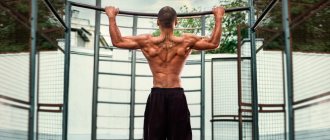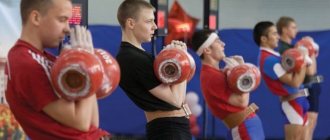For every athlete, even a novice bodybuilder, supercompensation is one of the most important periods of the recovery process, without which muscle growth is simply impossible. Knowing the principles of building loads and rest, a beginner will be able to correctly organize his regime for effective hypertrophy, and an advanced athlete will be able to move forward when progress stops. Therefore, below we will reveal in detail the essence and method of identifying the supercompensation phase in simple language.
What is supercompensation in sports?
Supercompensation or super-recovery is a phase of the recovery process in which the level of physical capabilities of the body exceeds the level before the onset of the load.
Example: there is an initial indicator at which an athlete is ready to perform a particular load. During this same load, muscle fatigue occurs due to depletion of glycogen and creatine phosphate reserves. This period means a loss of strength, that is, the indicator on the graph falls. Then comes a period of recovery, in other words, rest, during which the physical capabilities of the body increase and reach their peak, which exceeds the initial value, compensating for it. This is supercompensation. Thus, during this period, the athlete’s capabilities are at their peak and he can perform a load that exceeds previous indicators.
It is logical to assume that after each workout the body becomes stronger or more resilient, for example, in powerlifting or running, if training is carried out during the period of supercompensation. This explains that the athlete becomes better with each training session, but it is important to organize the correct training and rest regime.
If you ignore the super-recovery phase, you can either become overworked or not develop at all.
This theory was studied by physiologist Karl Weiger at the end of the nineteenth century, calling it the “law of supercompensation,” and in the mid-twentieth century Yakovlev became his follower, who continued to study the training effect.
To make it clearer, on average, supercompensation occurs 2-3 days after the load, but these indicators are individual. This explains why it is better to use a three-day split in bodybuilding, especially for beginners. This is because the body is fully restored and is ready to further increase its level of fitness.
What happens if you ignore such a phenomenon as super recovery:
- If you do not wait for the onset of that very supercompensation and train diligently every day, then the fitness indicator will constantly decrease and lead to the opposite effect - overtraining. An exhausted body will lose its capabilities that it initially possessed. Professional athletes often hit a training plateau because of this.
- If you skip supercompensation and train rarely - 1-2 times a week with low intensity, then the body simply will not increase its fitness and will remain in place. Therefore, this is not a suitable mode for bodybuilding or powerlifting.
Supercompensation[edit | edit code]
Super compensation
Super compensation
— the post-training period, during which the trained function/parameter has a higher rate compared to the initial level.
The supercompensation phase was first described by B.S. Gippenreiter in 1953 in his work.
According to scientific data, there are three main phases of recovery after training:
- the first phase is the recovery phase, during which tissue repair occurs, during this period the function is restored to its original level
- the second phase is supercompensation, during which increased performance is observed, which can exceed the initial level by 10 - 20%
- the third phase is the phase of gradual return to the original level of performance.
The principle of training planning
Repeated performance of muscular work - physical exercises over a number of days and months leads to an improvement in function or an increase in the trained parameter (muscle mass), which determines the possibility of physical development and improvement of a person.
In bodybuilding, you need to strive to ensure that each subsequent workout falls at the peak of the supercompensation phase. At first glance, this seems like a simple task, but supercompensation occurs at different times in different people, and there are no simple objective measures to identify it. Another problem is that when it comes to gaining mass or increasing strength, there are a number of parameters that become supercompensated at different times, so training frequency is very important in bodybuilding.
Read the main article:
Optimal training frequency
Solving the problem of supercompensation[edit | edit code]
To solve the problem with a number of parameters, supercompensation of which occurs at different moments, it is proposed to divide the training program into microcycles, where each microcycle is responsible for the development of a certain parameter. The simplest solution is split training, which should be performed in different intensity modes. That is, each muscle group should be trained with varying degrees of intensity from one session to the next: light - medium - high - and so on, read periodization for more details. Thanks to this approach, it is possible to maintain different parameters in the compensation phase and prevent the development of adaptation to loads.
Criticism[edit | edit code]
Professor Viktor Nikolaevich Seluyanov believes that the concept of “Supercompensation” is built on false grounds
Recovery phases
- The first phase of the cycle is receiving the load. During exercise, fatigue always occurs, that is, the pre-load indicator decreases.
- The second phase - a recovery period begins, which can be divided into the following phases: recovery , in which the indicator of physical capabilities increases and reaches the level of the initial indicator; supercompensation - an increase in the initial indicator by 10, or even 20%.
- Return – after super-recovery, there is a return to the initial indicator of the first phase of the cycle.
This is an example of one cycle - load and recovery.
If you constantly train at the onset of the supercompensation phase, then the last return rate will grow and exceed the previous initial rate.
Trained functions and qualities
Main functions that need to be improved:
- Creatine phosphate restoration (2 to 10 minutes).
- Processing of lactic acid (from 1 minute to half an hour).
- Compensate for glycogen (1 - 3 days).
- Compensate for proteins (3 - 5 days).
In addition to these functions, it is important to restore the nervous and energy systems. Each of the above body functions is restored in a different time period; it is impossible to restore everything at the same time.
For example, after completing a workout, creatine phosphate will be restored first, but other functions will still be low. But when protein levels are restored, other functions will lose supercompensation. Therefore, different time frames for recovery are called heterochronism.
How to properly build a workout for supercompensation
The most suitable method of strength training is split, when 2-3 muscle groups are loaded in one workout. This way, the muscles have time to recover before the next workout.
For constant progress, the load must be increased, which will hinder the achievement of muscle adaptation. But you also need to increase the load correctly, namely, resort to cycling.
Cycling involves gradually increasing the difficulty of the training process throughout the week, followed by a decrease at the beginning of the next training week. A constant increase in load, for example working weight, every subsequent week also plays a role here.
Example:
- Monday – light training.
- Wednesday – moderate training.
- Friday is a tough workout.
Also, during the week, a working weight of 40% of the one-repetition maximum is selected. The second week goes exactly the same way, only the working weight increases to 50% of the repeated maximum and so on up to 80%.
Returning to moderate exercise allows you to continually progress without reaching overtraining, which leads to a training plateau.
About Tapering
Tapering is a time period before a competition, when the load is projected in such a way as to eliminate the stress accumulated during the preparation period and ensure access to supercompensation in the required time period.
In other words, a sustained reduction in physical activity at a specific point in time before a competition reduces the resulting stress of everyday training and improves athletic performance.
Energy is restored and toxins are removed from the body.
As a result of tapering, the body's capabilities increase, despite the tedious process. In this regard, the level of sports achievements increases.
Ways to speed up recovery
After the workout, there is pain and a feeling of congestion in the muscles. This is due to the accumulation of lactic acid in muscle tissue.
This is a breakdown product and in order to remove it from the body as quickly as possible, it is necessary to speed up recovery.
It can be passive, when you rest after training, or active. Active recovery includes massage and light exercise.
Supercompensation and unloading stage
When the human body has approached the stage of overload, the volume of training must be reduced to 50%, and the intensity, on the contrary, increased by 5%. For clarity, you perform a bench press of 90 kg for 6 sets of 10 repetitions, at the last stage of overload (last week), you need to reduce the volume of training to 3 sets of 10 repetitions, and take the weight to 94.5 kg.
Higher intensity continues to stimulate muscle stimulation. For supercompensation to be successful, in addition to training, you need to pay close attention to nutrition and sleep.
Tips for better recovery after a powerful workout include:
- sleep at least 7 hours daily;
— after the end of heavy training, you need to eat for another 1-2 weeks the same way as during powerful training, a sufficient amount of macronutrients is necessary for the muscles to recover after heavy loads;
- daily consumption of BCAAs and fish oil between main meals.
Goal of training
It is important to understand that if you are not a professional athlete, if you are not passionate about it, you cannot play sports all the time. This is true for most people - it is impossible to maintain high physical activity all the time, otherwise everyone would already be doing it.
Everyone can periodically turn to growth and development in this area in order to improve their physical performance. But few people do it all the time because most people don't have a passion for athletic performance every season.
| The theory says that if we do several “work-rest” cycles within the training year, then we can not only maintain our body, but also achieve small progress, which then stays with us. |
The maximum task is to give yourself a load every training session that would be quite high within the acceptable limits. The only important thing is to understand what your acceptable limit is. A high load within the acceptable limit is simply a mathematical calculation that you can do and compare with your feelings.
Imagine your corridor of opportunity.
There is maximum work , for example, you can run high speed as fast as possible for five seconds, if you run for 10 seconds, this is no longer 100% of the maximum. There is sufficient work 85% of the maximum for most of the workout, or at least in each interval .
Each workout has a specific task. There are cardio workouts where we train the heart and endurance so that the body quickly adapts to changes. Here the permissible norm is determined by your well-being, your pulse zone.
The best way to monitor your heart rate is with a heart rate monitor. When things get really hard and you want to stop, you look at your heart rate monitor and see that your heart rate is going over 180. This doesn’t mean that the workout is bad, you just need to slow down and your heart rate will drop.
As for the strength load, within the framework of our complexes, most of us do not give ourselves enough of it, therefore, in order to reach 85%, you need to work with intervals, phases, go slower, always keep the muscle contracted, add mental effort, concentration on sensations . You need to work on this every strength training session, then there will really be progress, which will be expressed not only in body functions and appearance, but also in exercise technique.
Example of working with strength exercises: push-upsIf you have a fairly trained body and can do a lot of push-ups, then most likely you will not have any training effect when you work out as usual. You must definitely find a phase of work in which it is difficult for you to stick to it. In order for your work in training to be effective, at the beginning of the interval, at the beginning of the exercise, you should work precisely in those phases where it is most difficult for you. This is exactly how the “weak” phases of movement are worked out, in which usually no one lingers, which “fly by” and are done due to inertia. First, you should ensure maximum fatigue of the muscle you are working on. Due to the fact that you have previously tired the muscle, the style of work will change when you continue to perform the exercise. For example, lower your chest to the floor and rise 1 cm up and so work until the technique fails. Then you start doing push-ups as usual, but your muscles work differently, and it becomes difficult for you to do those push-ups that were usually easy. After a short rest, you can try to work in the upper phase, also with a small amplitude, very slowly. The effect will be achieved due to the fact that you do the exercise not at your speed, not in your style, moving on to your usual mode of work later, after a short rest. |
Technique is a measure of how well you practiced the intermediate phases of an exercise. Strength is trained in the place where it manifests itself: where the muscle trembles, where it is difficult to hold on. You may feel like you're having a hard time everywhere and you can't seem to focus on any one thing, and that's something worth fighting through.
| If you are working at 85% of your maximum effort, then you can be sure that you will enter a period of supercompensation. |
This does not mean that if you do 75%, there will be no supercompensation. These are very relative indicators, and we can only check this by the result. A sports coach uses an experiment with his ward to see how long the ward rested after a certain load, and on which day he showed better or worse results.
A load of 75-85% is an extremely relative value, we cannot calculate it, so we can only roughly imagine what it is and test it in practice.
Under-recovery
The superload theory implies that a person does not increase the load step by step, but immediately gives himself something stressful, and this causes a powerful training effect in his body and an equally powerful recovery.
In this case, the next load falls on the phase of the under-recovered body. Then the effects are cumulative, and the supercompensation effect occurs after the completion of this cycle, and your compensation occurs after you have completed this block.
| A hard interval has its advantages: it gives a good load on the body. However, there is a problem: this is a serious physical activity that not everyone can endure without injury and complications. |
If a person previously led an unhealthy lifestyle or did not work with the body, he may become injured, and therefore this approach is not recommended for unprepared people.
WHAT IS OVERTRAINING?
Overtraining is an extreme state of fatigue or burnout resulting from excessive, accumulated training load with inadequate recovery. It is defined by a prolonged decline in productivity over several months and is sometimes called “unexplained underperformance syndrome.” [2]
If you experience the following symptoms for an extended period despite resting, your doctor may diagnose overtraining syndrome.
- Fatigue
- Depression
- Demotivation
- Insomnia
- Anorexia
- Weight loss
- Irritability
- Agitation
- Lack of mental concentration
- Bradycardia (heart rate below 60 beats per minute)
- Tachycardia (heart rate above 100 beats/min)
- Heavy, sore, stiff muscles
- Hypertension
- Anxiety
- Restlessness
- Waking up undiscovered
A temporary decrease in performance resulting from accumulated training load is defined as overshoot. Where the decline in performance lasts for a long time (several weeks), the condition is known as non-functional excess (NFO). Although full recovery is still possible, NFO results in lost training time and is therefore negative.
However, functional overexertion is a positive condition where the accumulated training load results in a short-term decline in performance (days to weeks), followed by supercompensation and increased performance. Many athletes strive for functional overexertion in order to maximize the effect of supercompensation.
Motivation and super compensation
If we were athletes with super motivation and the only goal was to win, we would train all year to track periods of supercompensation.
But since we are people with many other things and concerns, we have to reckon with the cycles of motivation, which we have been talking about for years - we get bored, we lose motivation and interest, and start doing something else.
When we get super motivated to train, we start training every day and don’t recover at all. Because “we can force ourselves!” If you are super motivated, you train very effectively, with a bang, you do everything and practice every day.
Day 3-4 comes when you lose mental concentration and simply cannot produce your result, cannot produce 85%, cannot force yourself, and you have no training effect. Yes, you're training at hard intervals, but that's not the maximum you can get out of those workouts.
If you ever train this way, notice when you can mentally intensify the workout and when the “just do it to do” moment comes. It is ideal to combine the training and supercompensation phase with the motivation phase in order to make the most of the resources we have.









